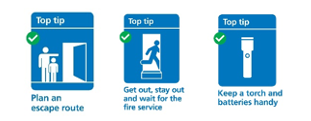
Having an escape plan for your household will help you to leave in a safe and orderly way.
1: Be Prepared:
- Develop an escape plan that includes all members of the household, including children and those with mobility issues.
- Identify two escape routes from each room (e.g., doors and windows). Consider installing locks or security features on your windows that give you a balance between security and ease of opening. Don’t use windows if you are higher up than the first floor.
- Make sure the keys to any locked doors are easily available on the route.
- Make sure everyone knows where the keys to windows and doors are located if they need to be unlocked for escape.
- Review the plan regularly, especially if there have been any changes in your home layout or household members.
2: Practice the Escape Plan:
- Carry out regular fire drills to practice the escape plan with all household members.
- Test your ability to respond to the sound of the smoke alarm and practice leaving in the dark to simulate a real emergency situation.
- Give each person a specific role, including supporting other family members who need extra help.
- Keep exits clear of obstructions, so you can leave quickly and easily.
3: Use Safe Escape Routes:
- In an emergency, get out as quickly as possible and don’t stop to collect personal belongings or valuables.
- Stay low to the ground where the air is clearer, and crawl to avoid smoke inhalation.
- If there’s too much smoke, use an alternative escape route if available.
- Close doors behind you to slow down the spread of fire and smoke.
4: Designated Meeting Point:
- Agree in advance a place away from the building where you will all meet to check everyone is safe and well.
- Do not re-enter the building for any reason